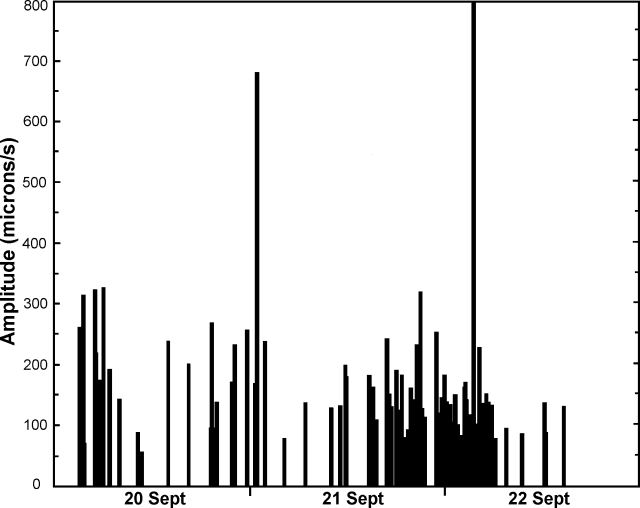Report on Monowai (New Zealand) — November 1996
Bulletin of the Global Volcanism Network, vol. 21, no. 11 (November 1996)
Managing Editor: Richard Wunderman.
Monowai (New Zealand) September T-waves from an interpreted eruption
Please cite this report as:
Global Volcanism Program, 1996. Report on Monowai (New Zealand) (Wunderman, R., ed.). Bulletin of the Global Volcanism Network, 21:11. Smithsonian Institution. https://doi.org/10.5479/si.GVP.BGVN199611-242050
Monowai
New Zealand
25.887°S, 177.188°W; summit elev. -132 m
All times are local (unless otherwise noted)
Monowai generated intense acoustic T-waves during 20-22 September (figure 2). During these three days, the seismic stations on Tahiti and Gambiers islands recorded >100 acoustic T-waves. This acoustic crisis, which occurred from 0230 on 20 September to 1358 on 22 September, began with a short explosion of high intensity that was followed by an amplitude-modulated noise during the first hour. Short explosions were sometimes associated with high-energy noise puffs. The two strongest puffs of noise were recorded at 0318 on 21 September and at 0256 on 22 September. There was an intense period of acoustic waves registered between 1404 on 21 September and at 0456 on 22 September. The intensity of acoustic waves began to decline at 0456 on 22 September. The event was interpreted as an eruption.
 |
Figure 2. Amplitude of acoustic waves recorded during 20-22 September (times shown are for signal origin at Monowai). Courtesy of Olivier Hyvernaud. |
Monowai Seamount also had a T-wave swarm in November 1995 (BGVN 20:11/12). Other noteworthy recent activity at Monowai included a possible eruption in 1944, and about seven documented eruptions during 1977-90 (BGVN 16:03). The seamount lies midway between the Kermadec and Tonga Islands, ~1,400 km NE of New Zealand. The adjacent trench is significantly shallower (~4 km) compared to the Tonga and Kermadec trenches (9-11 km deep).
Geological Summary. Monowai, also known as Orion seamount, is a basaltic stratovolcano that rises from a depth of about 1,500 to within 100 m of the ocean surface about halfway between the Kermadec and Tonga island groups, at the southern end of the Tonga Ridge. Small cones occur on the N and W flanks, and an 8.5 x 11 km submarine caldera with a depth of more than 1,500 m lies to the NNE. Numerous eruptions have been identified using submarine acoustic signals since it was first recognized as a volcano in 1977. A shoal that had been reported in 1944 may have been a pumice raft or water disturbance due to degassing. Surface observations have included water discoloration, vigorous gas bubbling, and areas of upwelling water, sometimes accompanied by rumbling noises. It was named for one of the New Zealand Navy bathymetric survey ships that documented its morphology.
Information Contacts: Olivier Hyvernaud, B.P. 640, Laboratoire de Geophysique, Papeete, Tahiti.

